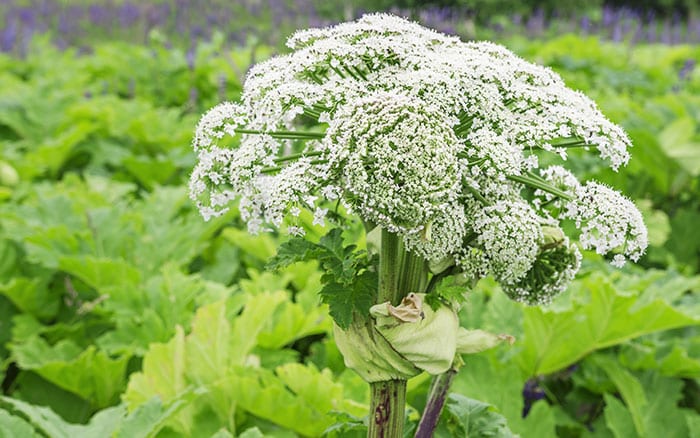Many non-native plants have enhanced our gardens in Britain, but a small selection of them are highly invasive which threatens habitats of wildlife and other plants.
By keeping an eye out for the following plants that are commonly found in the UK and getting a hold of them early, it reduces the risk of them damaging your glorious garden. For areas outside Britain, seek advice in your local district if you’re unsure about any potential invasive plants.
Giant hogweed
These weeds are tall with thick, bristly stems that are topped with white flowers facing upwards and can grow up to 10 feet high. Giant hogweed was first introduced to Britain and Europe from the Caucasus Mountains in the 19th Century.
To rid these from your garden try suppressing with mulch or digging it out. But be cautious to cover your arms and legs well and wear a mask, as the sap can be harmful to your skin if it comes into contact.

If non-chemical ways aren’t feasible visit your local garden centres for the best advice when using chemicals.
Japanese knotweed

They are fast growing weeds with tall, dense bamboo-like stems that produce leaves that are shovel shaped and can grow up to 14cm in length. This invasive plant has an extensive and strong root system, which is how the plant spreads as they don’t produce seeds.
Therefore, digging it out of your garden will be a real task due to its robust roots. When digging, it’s vital for all rhizomes to be unearthed and disposed of as pieces as small at 0.7 grams can grow into a new plant.
Rhododendron ponticum
The beautiful mauve, funnel shaped flowers may look pretty, but they have an adverse impact on wildlife. It was found that the number of earthworms, birds and plants in the area was lower as a result of the presence of this intrusive shrub. The Dormouse has been affected by this habitat loss because the Rhododendron ponticum has out-competed native plants which the mammal needs to survive.

Removing the shoots before implementing herbicide control will allow faster re-invasion of the plant. An effective method of control is to inject the stems with herbicide to keep it under control as it is a precise and direct measure. However, it is a challenging process so professional help is advised.
New Zealand pigmyweed

The New Zealand pigmyweed grows mainly in water, or soil with high water content, so is most likely to be seen near lakes or streams. The trailing stems of small, succulent leaves with small white flowers can put fish and frogs in danger if it layers over the surface of the water as it decreases the amount of oxygen that they have access to.
Digging up the weed and shading over it with black polythene has been shown to be a controlling measure.
Himalayan balsam
These giants can grow up to 2-3 metres in height and between June and October produce groups of purple-pink helmet shaped flowers which produce 800 seeds a year. They are very tolerant of shady spots and can become uncontrollable very fast due to being self-seeding plants. Their seeds are dispersed widely as the ripe seedpods shoot their seeds up to 7 metres away. Himalayan balsam is known to be spready by humans passing on seeds to friends, or by seeds being transported by water once established in the catchment of a river.

Digging it out before it has the chance to self-seed is a reliable and more environmentally friendly method.
Fish-pole bamboo

Phyllostachys aurea are graceful evergreen bamboos which can grow up to 8 metres in height. These are becoming more popular as they can add structural impact to borders. However, if they aren’t kept under control, they can become invasive and unsightly. Bamboo are strong plants and shoots can pop up anywhere from nearby land to growing through solid barriers such as patios or conservatory floors.
Invasive bamboos are classed as running bamboos and spread through long rhizomes, which assist the plan to take over new areas, another example is large-leaved bamboo.
Some bamboos are clump-forming rather than running bamboos and are less invasive. These include Chusquea culeou (Chilean bamboo) which can grow to 8 metres tall if positioned in full-sun or partial shade in a sheltered area or Fargesia nitida (Chinese fountain bamboo) which grows up to 4 metres with plenty of sun in either an exposed or sheltered position.
A top tip if you want bamboo to stay put is to plant them inside a physical barrier by digging a trench lined with solid materials such as paving slabs.
To rid them completely, digging out clumps of bamboo and restricting the size is the first solution, ensuring the rhizomes are severed as you go.
So, be sure to keep an eye out for these worrying weeds and get a hold of them before they have chance to harm your outdoor spaces and any wildlife that sees your garden as a home.

Leave A Comment